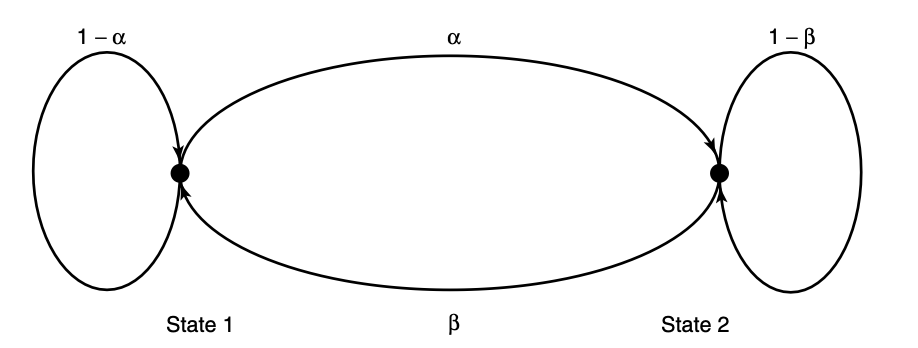Stationary Stochastic Processes and Markov Chains
- EE 376A: Information Theory. Winter 2018. Lecture 4. - Stanford University
- EE 376A: Information Theory. Winter 2017. Lecture 4. - Stanford University
- Elements of Information Theory
Stochastic Process
Definition: A stochastic process
The process is characterized by the joint probability mass functions
Stationary Stochastic Process
Definition: A stochastic process is said to be stationary if the joint distribution of any subset of the sequence of random variables is invariant with respect to shifts in the time index; that is,
Markov Chain
A Markov process or a Markov chain is a stochastic process indexed by time, and with the property that the future is independent of the past, given the present.
Markov processes, named for Andrei Markov, are among the most important of all random processes. In a sense, they are the stochastic analogs of differential equations and recurrence relations, which are of course, among the most important deterministic processes.
Source: Introduction to Markov Processes.
本文只讨论时间和状态空间均为离散的情况的markov chain.
Definition: A discrete stochastic process
We can denote them as
- Note: If there're only two r.v. s, say
PMF of a Markov Chain
The joint probability mass function of the random variables can be written as
Proof
let's prove this expression with mathematical induction:
Base Case (n = 2):
Inductive Step: Assume the expression holds for
Now, consider
- In the second line we apply
- In third line we apply our assumtion in the aductive step.
- In the second line we apply
This expression matches the assumed expression for
Hence, the joint probability mass function of the Markov chain can be written as:
Time Invariant
Definition: The Markov chain is said to be time invariant if the conditional probability
We will assume that the Markov chain is time invariant unless otherwise stated.
If
A time invariant Markov chain is characterized by its initial state and a probability transition matrix
If it is possible to go with positive probability from any state of the Markov chain to any other state in a finite number of steps, the Markov chain is said to be irreducible. If the largest common factor of the lengths of different paths from a state to itself is 1 , the Markov chain is said to aperiodic.
Properties
If random variables
- If
Conditionally Independence
Proof
==>
Given
Proof:
<==
Given
Proof: we just need to inverse the above proof:
Data Processing Inequality
Theorem(Data-processing inequality): If
Proof:
By the chain rule, we can expand mutual information in two different ways:
Since
Since
We have equality if and only if
Corollary
Corollary: In particular, if
Proof
Proof: We note in
Thus, the dependence of
Stationary Distribution
If the probability mass function of the random variable at time
A distribution on the states such that the distribution at time
Stationary distribution is so called because if the initial state of a Markov chain is drawn according to a stationary distribution, the Markov chain forms a stationary process.
If the finite-state Markov chain is irreducible and aperiodic, the stationary distribution is unique, and from any starting distribution, the distribution of
Example: Mickey Mouse Markov Chain
We consider an example of two-state Markov chain, which we call Mickey Mouse Markov Chain [MMMC], in order to understand basic properties of Markov chains.

The probability transition matrix of MMMC is:
//Can't understand:
Then the stationary probability can be found by solving the equation
For the stationary distribution, the net probability flow across any cut set in the state transition graph is zero. Applying this to Figure 4.1, we obtain
Since
If the Markov chain has an initial state drawn according to the stationary distribution, the resulting process will be stationary. The entropy of the
state
However, this is not the rate at which entropy grows for